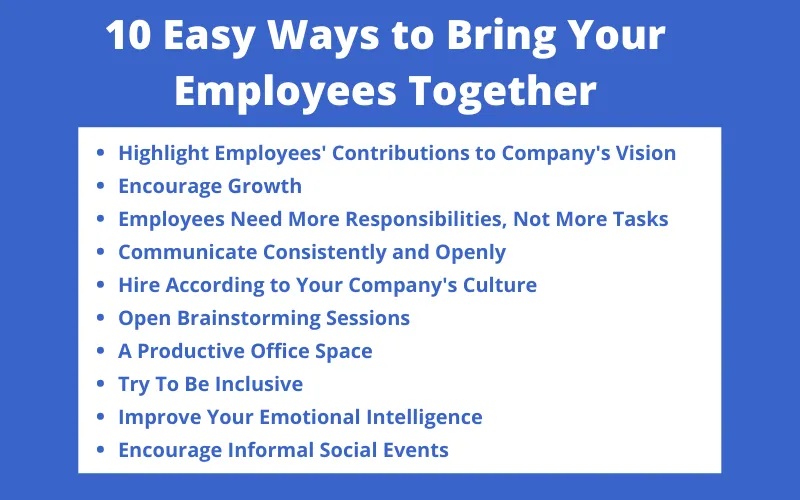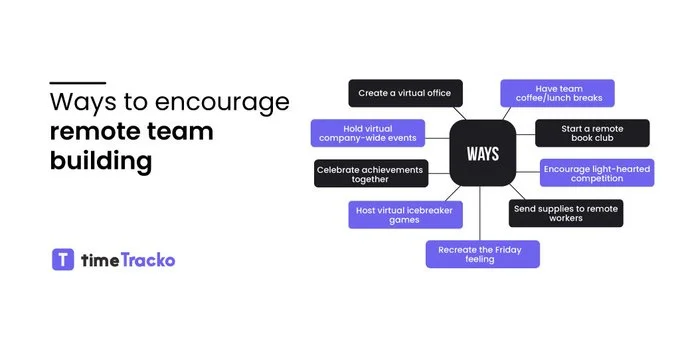10 Easy Ways to Bring Your Employees Together
10 Easy Ways to Bring Your Employees Together
A company or department that performs well together is more likely to succeed. Bring your employees together to improve your employee performance and thus support your company’s growth.
Everyone benefits from having pleasant interactions with colleagues and looks forward to working with them.
Even a single bad employee or bad relationship between employees can seriously impact morale and enthusiasm within a department.
Having a good working relationship with teammates can make work more fun. Good morale contributes to increased productivity, which, in turn, enhances results. It is always better to work in a high-morale environment than in a low-morale environment.
Work gets done faster when people care about their colleagues. People will go the extra mile when responsible and help solve problems without going up the chain.
Easy Ways to Bring Your Employees Together

1. Highlight Employees’ Contributions to Company’s Vision
Unquestionably, your company has set its goals and vision for the year. Why not have employees understand how their work contributes to its vision?
Instead of feeling like you hold a minor but necessary post in a large organization, employees will feel invested in the company’s success.
You can show employees how their contributions contribute to the company’s vision. How?
Make a list of responsibilities for a specific employee. Develop a flowchart showing how these duties ultimately lead to achieving the company’s vision.
Let’s say you’re responsible for managing an internet app. Your company’s vision is to influence how a younger generation buys homes, explain how the app can help you develop long-term brand recognition, and influence how they purchase homes in a few years.
The CEO should give you a quote that explains exactly how that employee’s role contributes to the company’s vision.
Print the quotation on postcards. Employees can pin the postcard to their walls as a constant reminder and motivator.
2. Encourage Growth

Every person should have the chance to improve themselves and grow professionally in the workplace. If you wish to support your team at work, create an environment where everyone can learn and grow.
Leaders need to provide opportunities for mentorship, training, and on-the-job learning. You can encourage your team to solve problems together if you promote skills among your team members.
Regardless of your level of responsibility, you can foster a working environment in which people want to learn and grow.
It doesn’t matter if you ask questions, help others understand, or undergo further training; you can keep growing.
3. Employees Need More Responsibilities, Not More Tasks
I have gained some interesting insights about engaging employees from working at a company that places a high value on morale.
My coworkers are more devoted to their work when given real responsibility, and states of “flow” seem to be abundant.
Please do not confuse this with adding more things to your team’s to-do list. They will take on important projects and initiatives that they will lead and succeed at.
People by nature are goal-oriented; when you give them something worthwhile, I believe you’ll be astonished by how much drive and purpose they’ll feel.
Consider giving one of your direct reports a large project to lead as a manager. On the other hand, you can ask your manager to assign you to a project that you think will help you grow.
Regardless of your experience, when you see your goal as crucial to the company’s success, you will find a way to accomplish it. Your work will become so much more meaningful.
4. Communicate Consistently and Openly
As a manager, you should communicate weekly to discuss where resources are needed, their new ideas, and how the work is going.
Management and direct reports will attend this weekly meeting to strategize how to improve their departments.
Engaged organizations rely on communication and remote work technologies to increase performance within teams.
Great teamwork starts with good communication. A great team communicates well, and often, its members are happy to share ideas, brainstorm together, get feedback, and even disagree with each other.
Members of the team may not always agree, but they can communicate through their differences to develop a solid solution and move forward as a team.
Communicate effectively with the team. Always be polite and clear about your visions and expectations.
Good communication involves both listening and speaking. Before offering your solutions and input, make sure you listen to your teammates and consider their thoughts.
5. Hire According to Your Company’s Culture
You’ll onboard employees who want to work with each other if you know your company culture and hire according to it.
In addition to presenting consistent messages about the values and the company mission, a positive corporate culture starts with the relationships between coworkers.
Consider brainstorming and writing down your organization’s cultural vision if you haven’t yet done so. Take a moment to identify the key traits you all seem to have in common with your colleagues.
You can determine how well an interviewee will fit into your culture once you have established a list of qualities. Be specific about the qualities you want.
Countless candidates are courteous and personable during an interview, so it’s vital you quickly dig deeper with candidates during the hiring process.
There’s a simple, three-word phrase to help you develop a deep understanding of the character and motivations of job candidates.
It will help you quickly determine if the interviewee possesses the qualities you identified as core to your company culture if you constantly ask for more information from them.
6. Open Brainstorming Sessions
Discard meeting rule books with agendas and targets, and don’t schedule meetings with agendas or targets.
An open brainstorming session is a great way to bounce ideas around and restate limitations. Mention something you would like to improve your business to begin the conversation.
Maintaining a positive atmosphere during brainstorming sessions requires a few ground rules.
Employees should be encouraged to keep an open mind and refrain from picking on others’ ideas, making automatic negative reactions, and asking questions that may stifle the flow of ideas instead of focusing on how to think about what and why.
7. A Productive Office Space
Are you working in a conducive environment for teamwork? Ideally, it would help if you had a physical workspace that supports collaboration.
Teams can use long-term project spaces, conference rooms that have the latest remote conferencing tools, and benching areas that enable people to do heads-down work while at the same time collaborating.
Taking into account your teams’ needs should guide your workspace design. Imagine your office can use impromptu huddles for productive discussions, knowledge experts are accessible, and co-working spaces are semi-permanent.
It is clear from watching how people, especially managers and executives, use or ignore informal collaborative areas that people feel they have permission to linger in these areas.
8. Try To Be Inclusive
There may be various people on your team that you should appeal to if you’re supporting them.
Accepting such a wide range of personalities, ways of doing things, and approaches may seem daunting, but it is necessary to accept these variations.
Often, ideas can be ignored or dismissed because they are not similar to your own. It may increase morale, but it can also create tension, causing those around you to feel ignored or unheard.
Your role may not matter, but you can make your team more effective if you recognize the importance of balance.
The importance of respecting and acknowledging differing opinions and viewpoints cannot be understated.
Often, these situations present learning opportunities and opportunities for demonstrating positive compromise and understanding. It is important to include everyone, and everyone should feel that their voice counts.
9. Improve Your Emotional Intelligence
Currently, employers are looking for employees with a high level of emotional intelligence. There is no wonder about this.
Understanding, using, and managing your emotions and reflecting on how you and others do the same is an essential skill.
Workplace collaboration and motivation are closely linked to emotional intelligence, often correlated with empathy and social awareness.
Teamwork effectiveness and job performance are higher when people have high levels of emotional intelligence.
Undoubtedly, this is one of those people skills that brings all sorts of benefits. Being self-aware, self-regulating, motivated, empathic, and socially skilled are all qualities of emotional intelligence.
If you want to make meaningful emotional connections with other people, try putting yourself in their shoes and observing how you react to them. Likewise, take a look at how you handle your work environment.
Do you have a strategy to help you deal with stressful situations? If not, what are your coping strategies? Whether you’re a manager or an intern, this skill will benefit both you and your team.
10. Encourage Informal Social Events
The words “bad team-building experiences” generate a litany of horrors even though certain HR manuals recommend formal team-building events.
It’s easy to find endless stories online of employees being forced to do things they don’t want to do, from bathing naked with managers to nearly being trampled to death by horses.
Some great ways exist for overcoming challenges associated with team building. Instead, it is ironic that forcing people to participate in compulsory team-building activities detracts from good teamwork.
HR managers might find it fun, but employees may find it degrading, and the last thing you want is resentment to build up.
It is more effective to allow organic team building instead of imposing it from the top down.
Getting to know one another in a low-pressure, informal setting will enable team members to form bonds that will extend to the workplace.
You can opt for low-key social gatherings instead of elaborate team-building events. The team will work better, and morale will increase, saving money and better results.
Conclusion
The importance of connecting with employees and bringing them together is necessary to improve employee productivity and expect the company’s growth.
In this article, you’ll find some amazing and easy ways to bring your employees together. Were our suggestions helpful?
Please let us know in the comment section below, and for more informative blogs, don’t forget to subscribe to the timeTracko blog.

 in Melbourne
in Melbourne 
 Employee Screen Monitoring Software
Employee Screen Monitoring Software App and Website Monitoring Software
App and Website Monitoring Software Time and Attendance Software
Time and Attendance Software Finance
Finance Banking
Banking Healthcare
Healthcare Lawyers
Lawyers Retail & ecommerce
Retail & ecommerce Knowledge base
Knowledge base Blogs
Blogs Installation Guide
Installation Guide FAQs
FAQs About
About Media Kit
Media Kit Contact us
Contact us